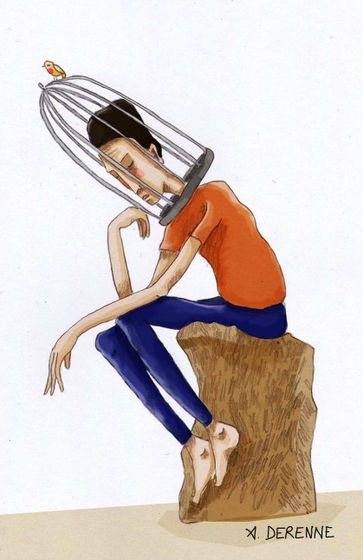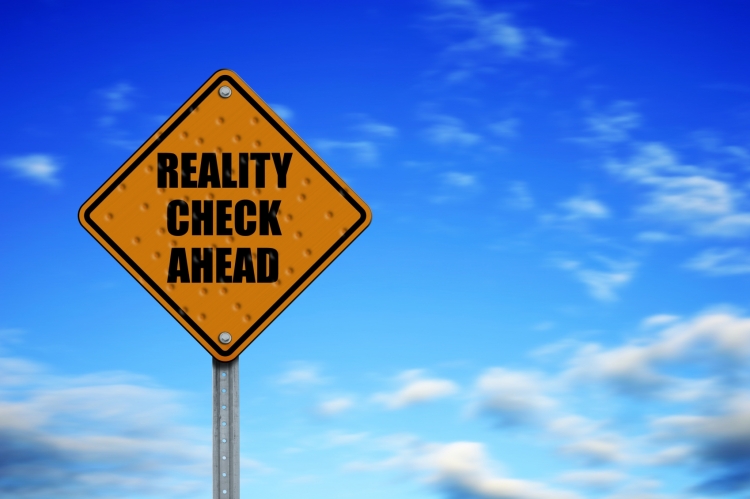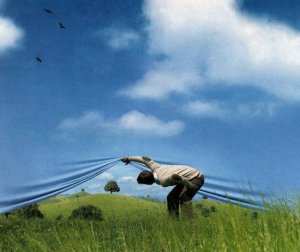The Process For Dissolving Mental Projections: Steps 3 & 4

This article continues my Jailbreak Your Mind series, which will form the basis of a self help book currently in the works. This follows on directly from the previous post.
The four step process for dissolving mental projections is:
1. Identify the projection
2. Reduce the subjective to the objective
3. Take any appropriate physical action
4. Change the thought
The last post explored the first two steps, which are the key. This entry will deal with the latter two.
Take any appropriate physical action
The final two steps are the optional ‘clean-up’, that may or may not be necessary. If it’s a ‘physical’ problem (ie., not simply a product of my thinking), then the next step is to objectively determine what I need to do to tackle it. If I have a headache, I take a painkiller. If I’m tired, I go lie down. If I’m feeling stressed or overburdened, I seek ways to reduce my load by delegating or ditching what I don’t really need to do.
Recognise the issue and, if need be, brainstorm ways that you can deal with it. Put your problem-solving skills to good use. See it as a challenge and recognise that, whatever the issue, you have or can access or develop all the resources you need in order to deal with it. This may involve asking other people for help, or developing certain skills or resources. There is a solution to any challenge we might face in life.
Let’s go back to our examples. The first one was ‘I am depressed at my lack of success in life’. When I stripped away my subjective interpretation I realised that the reality of the situation was that I was making judgements about my life. Because my life hadn’t conformed to my idea of what I think it should be, I was suffering. It wasn’t actually ‘my life’ that was causing me to suffer, it was the thoughts I was thinking about it; my story about it. Simply realising this may have been enough to end the problem. Perhaps now I recognise that life isn’t designed to match up to what we think it should be, and it never will! Perhaps I can accept this and learn to enjoy the upside of life and take things as they come. Or perhaps I can identify some areas where I can make some improvement and decide to commit to that. Maybe I could get more education, or change my job, or start a business. There’s nothing to stop me.
Take the issue you’re working with, keep it at the objective level, and see if there is any physical action you want or need to take. There may be some action you need to take or you may find that, like the travelling monk, the issue completely disappeared when you realised the nature of your superimposition: i.e., there was never a snake there to begin with, therefore there’s nothing to be done about it!
Objective Issue: My boss has been making unreasonable demands
Objective ways to deal with it: Schedule a meeting. Share my concerns. Ask for greater support. If appropriate, work on improving my skills, time-management, etc. Or maybe look for another, better job.
Objective Issue: I am single and would like to be in a relationship
Objective ways to deal with it: Start dating again. Be clear on what I am looking for. Build my confidence and self esteem.
Objective Issue: I have been making judgements about my body
Objective ways to deal with it: Learn to love myself and my body. Learn to take care of my body. See and appreciate the very best about myself. Practise loving self-massage. Eat well and do some fun exercise to feel good
Change the thought
So we’ve reduced the subjective to the objective, stripping away our mental story and reducing the object, situation or circumstance to its own status. This has either made us realise that there is no problem at all; it was simply a problem in our imagination, or, if there was a physical component to the problem, it enabled us to take a clearer and more objective look at how we ought to proceed.
That may be all that we need to do. Our brave traveller didn’t need to fend off that snake at the well or run for his life. All he needed to do was leave his subjective reality and come back in touch with objective reality and realise that the snake had no existence other than a thought, a misperception in his mind—and poof, the ‘snake’ disappeared, never to return.
Given that most problems start off on the level of mind, that’s where they will be resolved. Very often the final step is to change the problem by changing our thought about it. If the problem is our mental story, then we need to rewrite that story.
Again, objective reality is neutral in itself. Shakespeare summed it up perfectly in Hamlet:
“Nothing is either good or bad, but thinking makes it so.”
We project interpretations on reality and those interpretations are based upon our experience, conditioning, likes, dislikes, desires, fears and beliefs. Again, if those interpretations are working for you—which is to say, you are going through life in a relatively peaceful, happy, satisfied state, then you are welcome and advised to hold onto those interpretations. You need only question them when they begin causing suffering and dysfunction for you and those around you.
Emotional pain is a sign that your thoughts and interpretations aren’t working for you; that there’s a core conflict that must be resolved. In this way, negative emotions are actually a positive thing. Pain is a mechanism designed to alert us to a problem, to action that needs to be taken on some level. Physical pain is dealt with on the level of the physical. If you burn yourself, the pain immediately alerts you to remove yourself from the source of heat.
Emotional pain is dealt with on the level of mind. When it’s not legitimate, clean pain, it’s a sign that there’s a problem on the level of our thinking, interpretations and projections. That’s where the problem lies and that’s where the problem will be solved. The great problem in our culture is that we simply aren’t raised with the tools we need to be able to navigate this inner world; the world of our thoughts and feelings and the immense cause and effect relationship between them.
I’ve run the risk of repeating myself ad nauseum as I’ve run over this process, but it’s necessary to continually hammer this home until it ‘clicks’. Because when it does, our relationship with reality changes forever. What we’ve learned to do is to strip away the mental story we’ve imposed on reality. We’ve essentially deconstructed our interpretation of reality. This is not something we need to do just once in order to be free. It needs to become a habit. We need to continually keep pulling ourselves out of our illusory subjective realm and back to objective reality time and time again, until it becomes second nature, an instant reflex.
 As we’ve seen, the subjective realm is not a direct, accurate representation of reality. It’s an indirect, conditioned and distorted reflection of empirical reality. Deconstructing our story enables us to see that our original issue was either an illusory problem that didn’t really exist, or was an issue that did have some physical component but which was most likely exacerbated or distorted by the mind. The way to clear things up for good is to change things on the level of thought. This involves a process called reframing. If it’s your story that’s been causing the problem, and it very often is, then it’s time to rewrite that story!
As we’ve seen, the subjective realm is not a direct, accurate representation of reality. It’s an indirect, conditioned and distorted reflection of empirical reality. Deconstructing our story enables us to see that our original issue was either an illusory problem that didn’t really exist, or was an issue that did have some physical component but which was most likely exacerbated or distorted by the mind. The way to clear things up for good is to change things on the level of thought. This involves a process called reframing. If it’s your story that’s been causing the problem, and it very often is, then it’s time to rewrite that story!
This is a simple process—although, again, simple doesn’t necessarily mean easy. It may take some time and practise to master the art of reframing.
Take the original subjective interpretation that was causing the problem for you. Firstly, recognise that it is just an interpretation and usually one that was made quite unconsciously, based upon the mind’s habitual tendency to process reality a certain way. Recognise that it was only one of many different interpretations you could have made regarding the issue or situation. Take a moment to consider what other, more positive interpretations you might give the same issue. How might you reframe the situation in a more positive light? In what ways might this situation actually be a good thing?
Let’s use one of our original examples. How might “I’m depressed at my lack of success in life” be reframed? In step two we already deconstructed this thought by seeing that the real problem was my notion that life should match up to what my mind thinks it should be. A mature, objective mind knows that life simply doesn’t work like that! Getting depressed because life isn’t giving me what I want is actually a rather childish state of mind (and yet it is the source of so much of our suffering).
Reducing it to the objective level, I realise that my life is a certain way and I am creating an inner resistance to that. In step three I realised that I can take action to change things on a physical level. I might want to do that, or I might by now have realised that the real problem was the way I was choosing to interpret my life situation. So in this step, having realised the problem was my largely just interpretation, my story, I now have the opportunity to change things on the level of thought. The moment we change the way we look at things, our entire experience changes—an alchemical process that happens from the inside out.
I’m going to reevaluate the thought “I’m depressed because of my lack of success in life”. That interpretation, the notion that I’m not successful and that my life is a mess, is the root of my problem and it’s causing a great deal of suffering. What if I instead decided to see things in a more constructive light? What if I changed it to: “life is giving me new challenges and opportunities to grow and change”. This is instantly more empowering, and it’s just as true, if not more true, than my original interpretation. I’m no longer wallowing in self-pity and judging myself and life as harshly. This new thought, this rewritten story, is motivating and encouraging. Rather than feeling depressed and deflated, I’m much more likely to be at peace and even excited at the opportunities I have to play with my circumstances and to explore different possibilities.
It’s all in the way we choose to look at things. Again, it bears repeating; any form of mind-created emotional stress or suffering is a sign that we are thinking low quality thoughts. What we’ve been doing is telling ourselves horror stories about ourselves and our lives, or stories on a par with the classic Greek tragedies—and then wondering why we’re feeling anxious, stressed and emotionally beaten!
The mind works like a computer. The input will determine the output; and so will the software we’re running. If there are glitches in our programming, this will distort everything and create one big, buggy mess that’s prone to malfunction and crashing. It doesn’t have to be that way. If our mind is giving us problems, this is simply a sign that we need to learn how to use it better and more efficiently.
That’s what the next part of this series will focus on: going deeper into how the mind works and how we can shift negative thoughts, beliefs and painful emotions. You might want to take some time to reflect on these essays and learn the master the 4 step process for dissolving projections before moving on. This is one of the foundational practises for jailbreaking the mind. It should be done over and over until it becomes a habitual response to life. Whenever things are getting on top of us, we need to quickly shift out of the subjective and reduce it back to the objective. For there lies our true point of power and stability. We are coming back to reality and back to ourselves.





 The monk squinted. Now the old man’s lamp was illuminating the dark, he could see that he was indeed correct. What had presumed was a snake was in fact a rope coiled around a bucket at the side of the well, the tip of the rope sticking up like the head of a snake.
The monk squinted. Now the old man’s lamp was illuminating the dark, he could see that he was indeed correct. What had presumed was a snake was in fact a rope coiled around a bucket at the side of the well, the tip of the rope sticking up like the head of a snake.














